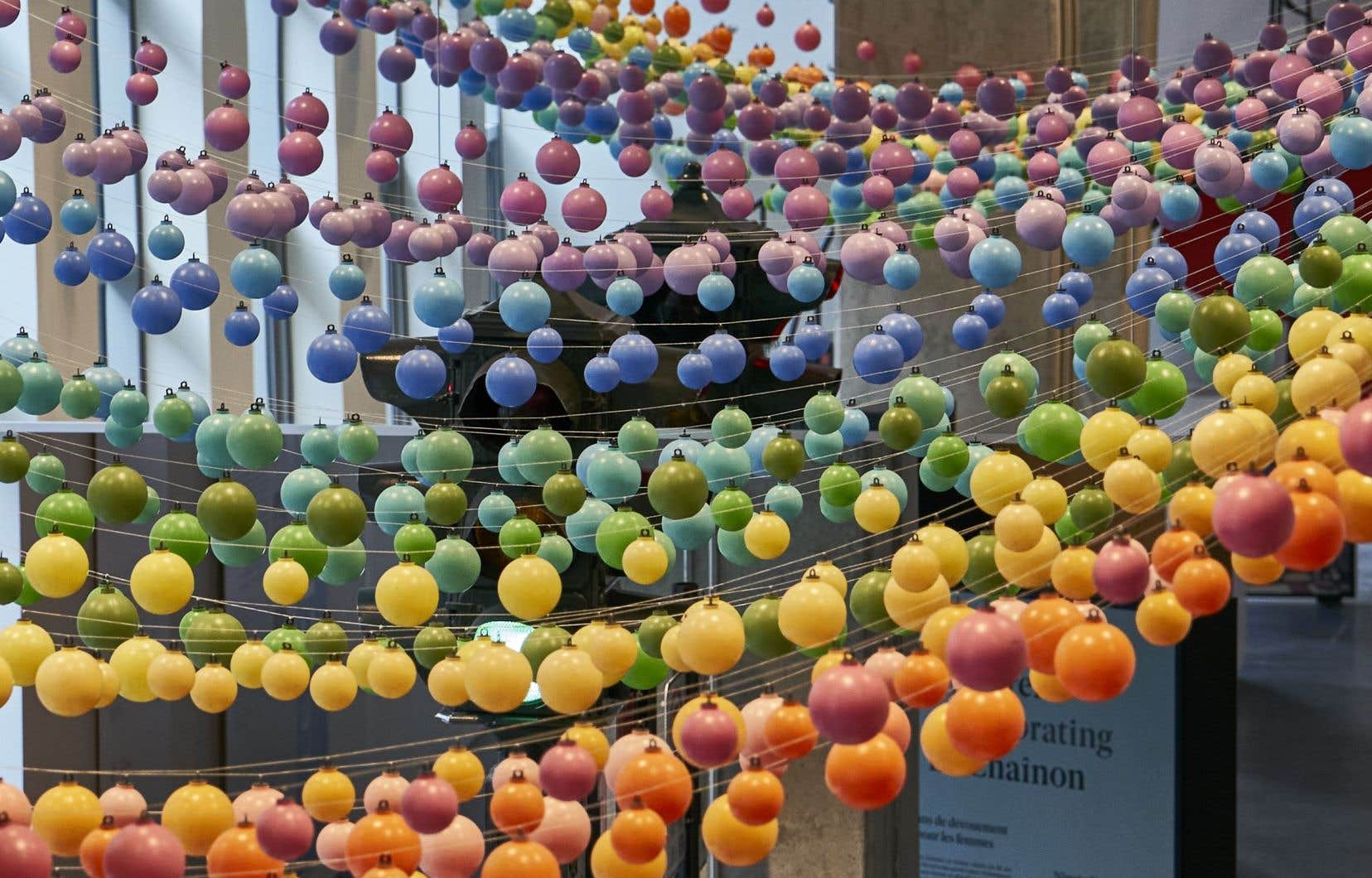This text is part of the special notebook Center of Montreal Memories
Five members of the MEM team take up their pen to present their favorite object from the collection.
Installation “18 shades of cheerful”
Installation 18 shades of cheerful, which has become emblematic of the Village, is the work of the landscape architect firm CCxA (formerly Claude Cormier + Associés). It was presented over a kilometer along Sainte-Catherine Street East between 2017 and 2019. It was composed of the 6 colors of the Pride flag, each available in three shades, forming a set of 18 shades totaling 180,000 balls of two different sizes. After being dismantled in 2019, the balls were put on sale until April 2021. The MEM wanted to acquire a sample of each shade, but those evoking Pink Balls, the first installation from 2011, were gone so quickly that it was no longer available. There was more left! Fortunately, thanks to a loan from the Gay Archives of Quebec, the MEM was able to add the iconic candy pink. In addition to decorating several balconies, terraces and courtyards in Montreal, balls of 18 shades of cheerful now compose a miniature reconstruction of the installation, which you can admire this fall above the “terrace” in the public spaces of the MEM.
Sophie Poirier, cataloger
Plaque in the name of Amherst Street
When a street changes its name, a plaque with the new name is added, but the plaque with the old name remains in place for a certain time, crossed out with a red diagonal to indicate the change. The Amherst Street plaque in the MEM collection has undergone such a transition. In 2019, the street became Atateken (pronounced “a-da-dé-gan”). Why this change? Amherst Street was reminiscent of Jeffery Amherst, commander-in-chief of the British armies in the 1760s. He had deep contempt for the First Peoples, going so far as to suggest contaminating them with smallpox. In a context of decolonization and reconciliation between Indigenous and non-Indigenous people, the toponym has been the subject of numerous criticisms. Based on consultations and the recommendation of the Montreal Native Toponymy Committee, the City finally renamed the street “Atateken”, a term in Kanien’kéha (Mohawk) which evokes fraternity.
Linda Rougeau, cultural events and reservations assistant
St. James United Church sign
When entering the MEM, it’s impossible to miss the impressive sign of the Saint-James United Church. The largest object in the collection is six meters high and almost two meters wide! Blue and red neon lights in Gothic lettering illuminate the hand-painted metal structure, shaped like a church window. Many still remember it when it hung in the row of businesses that separated the church from the street. Until 2005, the sign marked the passage leading to the church. In competition with neighboring commercial signs, its size and neon lights ensured good visibility. From the 1920s to the 1960s, Sainte-Catherine Street was known for its lively nights lit up with neon lights. The Saint-James sign is one of the rare survivors from this era. Preserved for more than 15 years in the basement of the church, it was restored for the inauguration of the MEM, where it lives again today, a few streets east of its original location.
Marie-Anne Gagnon, curator
Artwork “Garbage Beauty”
The MEM’s mission is to preserve the memory and traces of all Montrealers in their daily activities, whatever their ages, origins, resources, places of life, etc. It is with this in mind that street art also has its place in the museum. When representing the multiple faces of the alleys, the MEM did not want to simply evoke or imitate without really knowing the codes of street art. This is why we had the chance to collaborate with the artist Romain Boz, one of the authors of the Garbage Beauty which transforms large trash abandoned on the sidewalks into beautiful and poetic works that last… Until they are collected by the City. It is also for this reason that the tag featured on the wall in this area is that of Scan, in homage to one of the most recognized artists in the field, now deceased.
Stéphanie Mondor, technical manager of exhibitions and collections
Traffic light
Montreal, 1910. Pedestrians, horses and trams share the city’s streets with 489 automobiles. Travel by car increased, as did accidents: the first pedestrian was fatally struck on rue Sainte-Catherine in 1906. Traffic jams appeared. Over the years, the number of automobiles continues to increase. Police officers must be stationed at strategic intersections to ensure traffic flow. The situation becomes untenable… After conclusive tests with a prototype installed on Craig Street (now Saint-Antoine), the first traffic light was installed at the corner of Sherbrooke West and University Streets in 1930. The traffic light in the collection of MEM is one of the first to be in service in Montreal. It is the presence of the City’s coat of arms, as designed by Jacques Viger in 1833, before their modernization in 1938, which allows us to determine this.
André Gauvreau, assistant to cultural events and partnerships
This content was produced by the Special Publications team at Duty, relating to marketing. The writing of the Duty did not take part.
